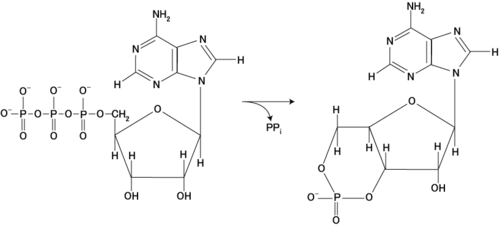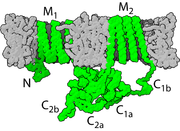
Adenylate cyclase
Encyclopedia
Adenylate cyclase is part of the G protein
signalling cascade, which transmits chemical signals from outside the cell across the membrane to the inside of the cell (cytoplasm
).
The outside signal binds to a receptor, which transmits a signal to the G protein, which transmits a signal to adenylate cyclase, which transmits a signal by converting adenosine triphosphate
to cyclic adenosine monophosphate
(cAMP). cAMP is known as a second messenger.
s:
the conversion of ATP
to 3',5'-cyclic AMP (cAMP) and pyrophosphate
.
 cAMP (cyclic adenosine monophosphate) is an important molecule in eukaryotic
cAMP (cyclic adenosine monophosphate) is an important molecule in eukaryotic
signal transduction
, a so-called second messenger. Adenylate cyclase can be activated or inhibited by G protein
s, which are coupled to membrane receptors and thus can respond to hormonal or other stimuli. Following activation of adenylate cyclase, the resulting cAMP acts as a second messenger by interacting with and regulating other proteins such as protein kinase A and cyclic nucleotide-gated ion channels
.
Photoactivatable adenylate cyclase (PAC) was discovered in E. gracilis and can be expressed in other organisms through genetic manipulation. Shining blue light on a cell containing PAC activates it and abruptly increases the rate of conversion of ATP to cAMP. This is a useful technique for researchers in neuroscience because it allows them to quickly increase the intracellular cAMP levels in particular neurons, and to study the effect of that increase in neural activity on the behavior of the organism. For example, PAC expression in certain neurons has been shown to alter the grooming behavior in fruit flies exposed to blue light http://www.nature.com/nmeth/journal/v4/n1/abs/nmeth975.html. Researchers also use channelrhodopsin-2 in a similar fashion.
 Adenylyl cyclase is a transmembrane protein
Adenylyl cyclase is a transmembrane protein
. It passes through the plasma membrane twelve times.
The important parts for its function are located in the cytoplasm
and can be subdivided into the N-terminus, C1a, C1b, C2a, and C2b.
The C1 region exists between transmembrane helices six and seven, and the C2 region follows transmembrane helix 12.
The C1a and C2a domains form a catalytic dimer where ATP binds and is converted to cAMP.
s (Gs stimulating activity and Gi inhibiting it), and by forskolin
, as well as other class-specific substrates:
In neuron
s, calcium-sensitive adenylate cyclases are located next to calcium ion channel
s for faster reaction to Ca2+ influx; they are suspected of playing an important role in learning processes. This is supported by the fact that adenylate cyclases are coincidence detectors, meaning that they are activated only by several different signals occurring together. In peripheral cells and tissues adenylate cyclases appear to form molecular complexes with specific receptors and other signaling proteins in an isoform-specific manner.
G protein
G proteins are a family of proteins involved in transmitting chemical signals outside the cell, and causing changes inside the cell. They communicate signals from many hormones, neurotransmitters, and other signaling factors. G protein-coupled receptors are transmembrane receptors...
signalling cascade, which transmits chemical signals from outside the cell across the membrane to the inside of the cell (cytoplasm
Cytoplasm
The cytoplasm is a small gel-like substance residing between the cell membrane holding all the cell's internal sub-structures , except for the nucleus. All the contents of the cells of prokaryote organisms are contained within the cytoplasm...
).
The outside signal binds to a receptor, which transmits a signal to the G protein, which transmits a signal to adenylate cyclase, which transmits a signal by converting adenosine triphosphate
Adenosine triphosphate
Adenosine-5'-triphosphate is a multifunctional nucleoside triphosphate used in cells as a coenzyme. It is often called the "molecular unit of currency" of intracellular energy transfer. ATP transports chemical energy within cells for metabolism...
to cyclic adenosine monophosphate
Cyclic adenosine monophosphate
Cyclic adenosine monophosphate is a second messenger important in many biological processes...
(cAMP). cAMP is known as a second messenger.
Types
There are ten known adenylate cyclases in mammalMammal
Mammals are members of a class of air-breathing vertebrate animals characterised by the possession of endothermy, hair, three middle ear bones, and mammary glands functional in mothers with young...
s:
- ADCY1ADCY1Adenylate cyclase type 1 is an enzyme that in humans is encoded by the ADCY1 gene.-Further reading:...
- ADCY2ADCY2Adenylate cyclase type 2 is an enzyme that in humans is encoded by the ADCY2 gene.-Further reading:...
- ADCY3ADCY3Adenylate cyclase type 3 is an enzyme that in humans is encoded by the ADCY3 gene.-Further reading:...
- ADCY4ADCY4Adenylate cyclase type 4 is an enzyme that in humans is encoded by the ADCY4 gene.-Further reading:...
- ADCY5ADCY5Adenylate cyclase type 5 is an enzyme that in humans is encoded by the ADCY5 gene.-Further reading:...
- ADCY6ADCY6Adenylate cyclase type 6 is an enzyme that in humans is encoded by the ADCY6 gene.-Further reading:...
- ADCY7ADCY7Adenylate cyclase type 7 is an enzyme that in humans is encoded by the ADCY7 gene.-Further reading:...
- ADCY8ADCY8Adenylate cyclase type 8 is an enzyme that in humans is encoded by the ADCY8 gene.-Further reading:...
- ADCY9ADCY9Adenylate cyclase type 9 is an enzyme that in humans is encoded by the ADCY9 gene.-Further reading:...
- ADCY10ADCY10Adenylate cyclase 10 also known as ADCY10 is an enzyme that, in humans, is encoded by the ADCY10 gene.- Function :The protein encoded by this gene belongs to a distinct class of mammalian adenylyl cyclase that is soluble and insensitive to G protein or forskolin regulation...
Reaction
Adenylate cyclase catalyzesCatalysis
Catalysis is the change in rate of a chemical reaction due to the participation of a substance called a catalyst. Unlike other reagents that participate in the chemical reaction, a catalyst is not consumed by the reaction itself. A catalyst may participate in multiple chemical transformations....
the conversion of ATP
Adenosine triphosphate
Adenosine-5'-triphosphate is a multifunctional nucleoside triphosphate used in cells as a coenzyme. It is often called the "molecular unit of currency" of intracellular energy transfer. ATP transports chemical energy within cells for metabolism...
to 3',5'-cyclic AMP (cAMP) and pyrophosphate
Pyrophosphate
In chemistry, the anion, the salts, and the esters of pyrophosphoric acid are called pyrophosphates. Any salt or ester containing two phosphate groups is called a diphosphate. As a food additive, diphosphates are known as E450.- Chemistry :...
.

Eukaryote
A eukaryote is an organism whose cells contain complex structures enclosed within membranes. Eukaryotes may more formally be referred to as the taxon Eukarya or Eukaryota. The defining membrane-bound structure that sets eukaryotic cells apart from prokaryotic cells is the nucleus, or nuclear...
signal transduction
Signal transduction
Signal transduction occurs when an extracellular signaling molecule activates a cell surface receptor. In turn, this receptor alters intracellular molecules creating a response...
, a so-called second messenger. Adenylate cyclase can be activated or inhibited by G protein
G protein
G proteins are a family of proteins involved in transmitting chemical signals outside the cell, and causing changes inside the cell. They communicate signals from many hormones, neurotransmitters, and other signaling factors. G protein-coupled receptors are transmembrane receptors...
s, which are coupled to membrane receptors and thus can respond to hormonal or other stimuli. Following activation of adenylate cyclase, the resulting cAMP acts as a second messenger by interacting with and regulating other proteins such as protein kinase A and cyclic nucleotide-gated ion channels
HCN channel
Hyperpolarization-activated cyclic nucleotide-gated channels are proteins that serve as ion channels across the plasma membrane of heart and brain cells. HCN channels are sometimes referred to as “pacemaker channels” because they help to generate rhythmic activity within groups of heart and brain...
.
Photoactivatable adenylate cyclase (PAC) was discovered in E. gracilis and can be expressed in other organisms through genetic manipulation. Shining blue light on a cell containing PAC activates it and abruptly increases the rate of conversion of ATP to cAMP. This is a useful technique for researchers in neuroscience because it allows them to quickly increase the intracellular cAMP levels in particular neurons, and to study the effect of that increase in neural activity on the behavior of the organism. For example, PAC expression in certain neurons has been shown to alter the grooming behavior in fruit flies exposed to blue light http://www.nature.com/nmeth/journal/v4/n1/abs/nmeth975.html. Researchers also use channelrhodopsin-2 in a similar fashion.
Structure

Protein
Proteins are biochemical compounds consisting of one or more polypeptides typically folded into a globular or fibrous form, facilitating a biological function. A polypeptide is a single linear polymer chain of amino acids bonded together by peptide bonds between the carboxyl and amino groups of...
. It passes through the plasma membrane twelve times.
The important parts for its function are located in the cytoplasm
Cytoplasm
The cytoplasm is a small gel-like substance residing between the cell membrane holding all the cell's internal sub-structures , except for the nucleus. All the contents of the cells of prokaryote organisms are contained within the cytoplasm...
and can be subdivided into the N-terminus, C1a, C1b, C2a, and C2b.
The C1 region exists between transmembrane helices six and seven, and the C2 region follows transmembrane helix 12.
The C1a and C2a domains form a catalytic dimer where ATP binds and is converted to cAMP.
Regulation
Adenylate cyclase is dually regulated by G proteinG protein
G proteins are a family of proteins involved in transmitting chemical signals outside the cell, and causing changes inside the cell. They communicate signals from many hormones, neurotransmitters, and other signaling factors. G protein-coupled receptors are transmembrane receptors...
s (Gs stimulating activity and Gi inhibiting it), and by forskolin
Forskolin
Forskolin is a labdane diterpene that is produced by the Indian Coleus plant . Forskolin is commonly used to raise levels of cyclic AMP in the study and research of cell physiology. Forskolin resensitizes cell receptors by activating the enzyme adenylyl cyclase and increasing the intracellular...
, as well as other class-specific substrates:
- Isoforms I, III and VIII are also stimulated by Ca2+CalciumCalcium is the chemical element with the symbol Ca and atomic number 20. It has an atomic mass of 40.078 amu. Calcium is a soft gray alkaline earth metal, and is the fifth-most-abundant element by mass in the Earth's crust...
/calmodulinCalmodulinCalmodulin is a calcium-binding protein expressed in all eukaryotic cells...
. - Isoforms V and VI are inhibited by Ca2+ in a calmodulin-independent manner.
- Isoforms II, IV and IX are stimulated by beta gamma subunits of the G protein.
- Isoforms I, V and VI are most clearly inhibited by Gi, while other isoforms show less dual regulation by the inhibitory G protein.
- Soluble AC (sAC) is not a transmembrane form and is not regulated by G proteins or forskolin, instead acts as a bicarbonate/pH sensor.
In neuron
Neuron
A neuron is an electrically excitable cell that processes and transmits information by electrical and chemical signaling. Chemical signaling occurs via synapses, specialized connections with other cells. Neurons connect to each other to form networks. Neurons are the core components of the nervous...
s, calcium-sensitive adenylate cyclases are located next to calcium ion channel
Ion channel
Ion channels are pore-forming proteins that help establish and control the small voltage gradient across the plasma membrane of cells by allowing the flow of ions down their electrochemical gradient. They are present in the membranes that surround all biological cells...
s for faster reaction to Ca2+ influx; they are suspected of playing an important role in learning processes. This is supported by the fact that adenylate cyclases are coincidence detectors, meaning that they are activated only by several different signals occurring together. In peripheral cells and tissues adenylate cyclases appear to form molecular complexes with specific receptors and other signaling proteins in an isoform-specific manner.
External links
- Interactive 3D views of Adenylate cyclase at

